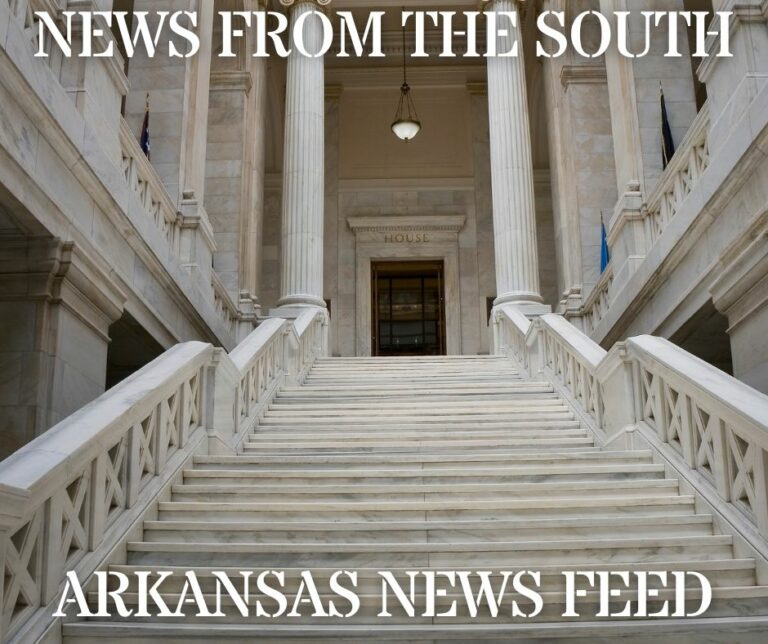News from the South - Kentucky News Feed
Hard choices face Kentucky Republican tasked with recommending Medicaid cuts
by Jamie Lucke, Sarah Ladd and McKenna Horsley, Kentucky Lantern
May 12, 2025
As U.S. Rep. Brett Guthrie prepares to lead a debate on the future of Medicaid, his home state of Kentucky has more at stake than most.
Guthrie, R-Bowling Green, is chairman of a House committee that on Tuesday is set to start proposing $880 billion in federal budget savings over the next 10 years.
Guthrie’s assignment will be impossible, experts say, without cutting the federal-state program that pays for almost 1 in 3 Kentuckians’ health care and has become an underpinning of the state’s economy.
“Medicaid has become important to local economies throughout the state and a key pathway to health care for many Kentuckians,” says the Kentucky Chamber of Commerce in a statement last week that also mentions the Chamber’s “long voiced concerns about the impact of rising Medicaid costs.”
“Efforts to control Medicaid spending will be necessary,” says the pro-business group whose top recent priority has been continuing to lower Kentucky’s income tax. “Policymakers, however, will need to take a balanced approach with input from key stakeholders.”
Guthrie’s committee releases plan Sunday night
Guthrie, a West Point graduate and former state legislator, is not publicly discussing specifics ahead of the markup, a spokesperson for the committee said Friday.
On Sunday night, the committee released a plan that the New York Times reports “would cause millions of poor Americans to lose Medicaid health coverage and millions more to pay higher fees when they go to the doctor, but that stopped short of an overhaul that would make the deepest cuts to the program.”
Matt VanHyfte, director of communications for the House Energy and Commerce Committee, on Friday said “Chairman Guthrie and Energy and Commerce Republicans are ready to strengthen, secure, and sustain Medicaid for generations to come and for the Americans the program was intended to serve.”
Sounding a common GOP theme, he said Medicaid was intended “to assist the ‘traditional population’ which are expectant mothers, children, low-income seniors, and people with disabilities.”
Medicaid was expanded beyond that traditional role in 2010 when Congress — with no Republican votes — enacted the Affordable Care Act, a law that became known as Obamacare.
By then the number of uninsured had topped 46 million, nearing 1 in 5 Americans; medical bills were increasingly pushing sick people into bankruptcy as hospitals shifted costs onto the dwindling share of insured patients.
Under the Medicaid expansion, the federal government offered to pay 100% of the costs for state Medicaid programs to begin covering low-income, able-bodied adults who can’t afford or who lack access to private health insurance.
‘Salvation for small rural hospitals’
Kentucky, a poor state with lots of sick people, has aggressively embraced the new option, and that has “changed the dynamics considerably,” says Mark Birdwhistell, an expert on Medicaid and the University of Kentucky’s senior vice president for health and public policy.
The Medicaid expansion has been “a great benefit to the health care delivery system at the University of Kentucky and all over Kentucky, particularly Southeastern Kentucky,” Birdwhistell told the Lantern. “It’s been a salvation for small rural hospitals in Eastern Kentucky and good for health outcomes as well.”
Jason Bailey, executive director of the progressive Kentucky Center for Economic Policy, calls Kentucky’s Medicaid expansion “the most positive economic policy change in decades, especially in rural Kentucky” where he says it has created much-needed health-care jobs, “saved rural hospitals and propped up clinics and treatment centers” while “making our workforce healthier.”
Within a year of the Medicaid expansion taking effect in 2014, the rate of uninsured Kentuckians fell from 14.4% to 6.1%. In 2023, 5.6% of Kentuckians’ were uninsured compared to 8% of the U.S. population.
UK’s Birdwhistell has been spending a lot of time in Washington sharing his knowledge with Kentucky’s congressional delegation and with staff of the U.S. Department of Health and Human Services which oversees Medicaid, Medicare and the Children’s Health Insurance Program.
In an interview with the Lantern, Birdwhistell discussed some of the Medicaid proposals the Republicans who control Congress have been considering as they look for savings to pay for continuing tax cuts enacted in 2017 during President Donald Trump’s first term.
Lowering federal share would be $1.4 billion hit to Kentucky
The proposal that would be the “most problematic” for Kentucky, Birdwhistell said, is one to lower the matching funds the federal government pays for the Medicaid expansion. After paying 100% of the expansion for a few years, the federal match was lowered to 90%, leaving states to pick up 10% of the expansion cost.
By contrast, the federal government picks up 71% of the cost of insuring Kentucky’s traditional Medicaid population. (Kentucky receives a higher federal match than most because it’s based on a state’s per capita income and Kentucky’s is comparatively low.) Of Kentucky’s $19 billion Medicaid budget, almost $15 billion comes from the federal government and about $4 billion from state sources.
If Congress decides to lower the expansion match to the lower share for the rest of the program, Kentucky would have to provide an additional $1.4 billion to continue covering the almost 500,000 people in the expansion, according to an estimate by the Kentucky Cabinet for Health and Family Services. “It would be difficult for the General Assembly to come up with that amount of money,” said Birdwhistell.
Birdwhistell said he understands why some members of Congress question the more generous federal match for the Medicaid expansion, but said, “In Kentucky, in my opinion, the benefits outweigh the downside.”
Block granting Medicaid would threaten traditional population
Another option being floated would impose per capita caps on federal funding for Medicaid, in essence a block grant based on the size of the covered population, which Birdwhistell said would likely cause negative impacts for the traditional Medicaid population especially the disabled and frail elderly, new mothers and babies who need neonatal intensive care.
Under a cap, some patients could be denied care if their costs exceeded a designated amount, he said, making it difficult to administer and producing “negative policy outcomes.”
If a per capita cap is the Republicans’ chosen alternative, Birdwhistell said it would be better to apply it to the expansion population who are healthier, younger and cheaper to insure.
Among the almost 1 million Kentuckians covered by traditional Medicaid is Caden Plemons, 19, of Bowling Green. He has Down Syndrome and autism and is “primarily nonverbal,” says his mother Rheanna Plemons who worries lawmakers will subject Medicaid to “broad, sweeping cuts, without doing any research to ensure that it’s not decreasing the standard of care for individuals with intellectual disabilities.”
Caden also receives services through Kentucky Medicaid’s Michell P. waiver, which helps people who have intellectual disabilities live more independently. Caden’s community living supports include staff to help him with daily tasks like dressing and going to appointments and getting out to enjoy go carts and other activities.
“He’s thriving in the community because of the services that we have received over the last 19 years,” Plemons said.
Caden’s waiver also covers respite care so Plemons and her husband can “take a break every now and then.”
“Sometimes people don’t realize: if you have a child who has a severe disability, such as my child, that’s 24 hours a day care, seven days a week,” Plemons said. “I work. My husband works full time. So if we want to take a break, even to go out to have dinner with just the two of us, then somebody’s got to be there with Caden, even though he’s 19 years old.”
Work requirement expands bureaucracy
The plan released Sunday night by Guthrie’s committee includes a work requirement aimed at trimming Medicaid costs. In an an op-ed by Guthrie published in the Wall Street Journal, he wrote: “When so many Americans who are truly in need rely on Medicaid for life-saving services, Washington can’t afford to undermine the program further by subsidizing capable adults who choose not to work.”
Birdwhistell estimates that more than half of able-bodied Kentuckians covered by Medicaid — the working poor — already hold low-wage jobs. The income limit for most working-age adults to qualify for Medicaid is 138% of the federal poverty level. That works out to $44,367 a year for a family of four which “in some areas of the state is quite a few people,” said Birdwhistell.
Enforcing a Medicaid work requirement would require funding an expanded bureaucracy to keep up with new reporting demands and ensure compliance, Birdwhistell said.
The Republican-dominated Kentucky legislature this year enacted a Medicaid work requirement that will be up to Democratic Gov. Andy Beshear’s administration to bring online.
Critics view work requirements as a smokescreen for using red tape to push people off the Medicaid rolls.
Megan Rorex, a licensed clinical social worker and therapist in Bowling Green, predicts new reporting demands would snag her Medicaid-covered clients. Many of them work multiple part-time jobs, often at restaurants and elsewhere in the service industry. She said they would lack the time or bandwidth to keep up with an additional layer of paperwork in a program that she considers already overcomplicated. “Any bureaucratic policy that’s unnecessary is a problem to navigate if you’re already working multiple jobs. It adds another layer of stigma and stress,” she said.
Provider taxes and state directed payments
Some Republicans, including Russell Vought, director of the Office of Management and Budget and an author of the Heritage Foundation’s Project 2025 agenda for the second Trump administration, want to limit states’ use of levies on health care providers — called provider taxes — to leverage higher Medicaid funding from the federal government.
Kentucky levies a number of provider taxes that bring additional federal Medicaid funds into the state and pay for state directed payments that increase hospitals’ Medicaid compensation to levels that on average are what private insurers would pay for the same services. Directed payments bring $5.5 billion a year to Kentucky providers, most of it from the federal government.
So far, congressional discussion has focused on capping provider taxes at 5% of hospital patient revenue which would not affect Kentucky because provider tax rates here are below 5%, Birdwhistell said.
Kentucky is using these payments to incentivize quality improvements, such as more frequent well-child visits and screenings for disease. Hospitals must meet the quality objectives to qualify for the extra funding, which Birdwhistell says has been “extremely successful” in transforming UK Healthcare into a “value-based organization.” He said he’s advising federal officials that Kentucky’s use of provider taxes to improve quality are models worth replicating in other states.
Slow return on investment
A complaint voiced by some Republican state lawmakers during this year’s session in Frankfort is that Medicaid spending increases each year — almost $2.6 billion budgeted from Kentucky’s General Fund in fiscal year 2025 — without producing improvements in health outcomes.
Birdwhistell said it takes a long time to realize the return on investment in health care. “These are generational issues. It takes a person’s lifetime before you can say what the savings were.”
And Kentuckians are inching out of the nation’s basement on some health indicators.
In 2024, Kentucky ranked 41st among the 50 states — up from 45th in 2016-2021 — in America’s Health Rankings, an annual study by the United Healthcare Foundation based on a variety of health, behavioral and socioeconomic metrics.
On the upside,
- The rate of colorectal screenings in Kentucky rose from 20th nationally in 2022 to 10th in 2024.
- Kentucky’s obesity rank improved from 48th in 2022 to 40th in 2023.
- And Kentucky’s drug-related deaths declined from 47th highest among the states in 2022 to 45th in 2024. Medicaid has been the main source of funds for bringing down fatal overdoses and treating the opioid epidemic.
Kentucky ranked 16th nationally in availability of primary care providers last year, down from 11th in 2023.
The study also identifies plenty of room for improvement. Kentucky ranked 49th for adults with multiple chronic conditions in 2023 and 45th for percentage of households experiencing food insecurity in 2024.
KY’s Brett Guthrie holds plum chairmanship after raising big money for House GOP caucus
The politics
While Guthrie’s role in potential Medicaid cuts is not expected to hurt his chances next year for reelection to a 10th term, Republicans representing swing districts in Congress could face a voter backlash, and some are refusing to vote for Medicaid rollbacks pushed by more conservative colleagues. Republicans’ narrow margin in the House means even a few defectors could doom budget provisions, while a few midterm defeats next year could give Democrats control of the chamber.
Candidate Trump promised to protect Medicaid, and the White House reiterated that promise in March, but Trump also is urging Congress to enact the House budget blueprint he calls the “big beautiful bill” — goals that appear to be contradictory.
Guthrie will be a “key player,” says Birdwhistell, as his committee works this week to move the House budget proposal closer to a vote by the full House.
Tres Watson, a former spokesperson for the Republican Party of Kentucky, echoed the talking point that Guthrie is working to return Medicaid to its original, pre-Affordable Care Act role, “reining in what many Republicans view as out of control entitlement spending, getting away from what was originally intended to be … a trampoline, not a mattress,” Watson said.
Kentucky’s top Democrat, Gov. Andy Beshear, has joined Democratic governors in calling on Congress to protect Medicaid funding. In a Democratic Governors Association press call last week, Beshear, the group’s vice chair, told reporters that “gutting Medicaid would impact families in a substantial way.” He said half of Kentucky children and 70% of long-term care costs in Kentucky are covered by Medicaid.
“Massive cuts to Medicaid is an attack on rural America, and if they do it, these Republican representatives and senators are saying they don’t believe that the people of rural America deserve the same access to health care as those in urban America,” Beshear said. “Certainly it would devastate my state, but it would devastate so many of our communities in every single state across the United States.”
‘The only system in the world like it’
The fate of rural hospitals is bound to weigh on Republicans sent to Washington from red states. Even if hospitals are not forced to close, Medicaid cuts could force hospitals to lose services, says Ben Chandler, who retired last year as president and CEO of the Foundation for a Healthy Kentucky. Before that the Democrat was Kentucky attorney general and auditor and represented the state’s 6th Congressional District in Washington from 2004 to 2013.
For Chandler the debate highlights the need for broad reform that would move the U.S. away from relying on employers to provide health coverage through a for-profit insurance industry that wields enormous influence on Capitol Hill.
“It’s ridiculous we don’t have Medicare for all or whatever you want to call it,” said Chandler who voted against the Affordable Care Act in 2010 because a proposal for a government-run “public option” health insurance plan was removed from the bill as a concession to the insurance industry and its supporters.
Chandler called the U.S. system “accidental,” born of World War II wage caps that inspired employers to compete for workers by offering a hospitalization benefit.
The U.S. spends twice as much on health care per capita as other large, wealthy nations while U.S. health outcomes are far worse than those in other countries.
Says Chandler, “It’s the only system in the world like it.”
YOU MAKE OUR WORK POSSIBLE.
Kentucky Lantern is part of States Newsroom, a nonprofit news network supported by grants and a coalition of donors as a 501c(3) public charity. Kentucky Lantern maintains editorial independence. Contact Editor Jamie Lucke for questions: info@kentuckylantern.com.
The post Hard choices face Kentucky Republican tasked with recommending Medicaid cuts appeared first on kentuckylantern.com
Note: The following A.I. based commentary is not part of the original article, reproduced above, but is offered in the hopes that it will promote greater media literacy and critical thinking, by making any potential bias more visible to the reader –Staff Editor.
Political Bias Rating: Center-Left
This article provides a detailed overview of the political debate surrounding Medicaid budget cuts in the U.S., focusing on Kentucky. It presents viewpoints from both Republican officials advocating for Medicaid spending controls and Democrats emphasizing the importance of Medicaid for health coverage and economic stability. The coverage is largely factual and balanced but leans slightly left by highlighting the negative impacts of proposed Republican budget cuts on vulnerable populations, the benefits of Medicaid expansion, and critiques of conservative work requirements and spending cuts. The inclusion of progressive voices and concerns about health outcomes and rural hospitals contributes to a center-left perspective, while still maintaining substantive coverage of Republican stances and fiscal concerns.
News from the South - Kentucky News Feed
Budget Committee will vote to change industrial bond program
SUMMARY: On August 19th, the Budget, Finance, and Economic Development Committee will vote on changes to Lexington’s Industrial Revenue Bond (IRB) program. Proposed amendments include setting affordable housing requirements for projects with housing under Leaseback IRBs: 15-year terms require affordability for households at or below 80% of Area Median Income (AMI), and 10-year terms for those earning 80.1%-100% AMI. Additionally, the IRB program’s geographic scope will expand to support projects across the entire Urban Service Area, beyond the current limited zone. IRBs provide loans for developments that promote economic growth and job creation in Lexington.
The post Budget Committee will vote to change industrial bond program appeared first on lexingtonky.news
News from the South - Kentucky News Feed
WLKY interview on bullying prevention
SUMMARY: Carolyn Towns, a bullying prevention advocate and two-time author, shares her journey inspired by personal experiences of being bullied and her son’s bullying. Her children’s book, “Tiny But Mighty,” promotes using thinking skills over physical responses, while “Are You Raising a Bully?” guides parents, educators, and policymakers on preventing bullying and supporting both targets and bullies. Carolyn emphasizes early intervention, encouraging children to speak up as “Communication Commanders.” She advocates for federal laws mandating effective school bullying programs. Additionally, she developed the Bullying Buddy app, which alerts parents in real-time about bullying incidents. Carolyn conducts nationwide workshops empowering children to use their voices.
WLKY interview on bullying prevention
Subscribe to WLKY on YouTube now for more: http://bit.ly/1e5KyMO
Get more Louisville news: http://www.wlky.com
Like us: http://www.facebook.com/wlkynews
Follow us: http://twitter.com/WLKY
Instagram: https://www.instagram.com/wlky/
News from the South - Kentucky News Feed
AmeriCorps is under siege. What happens in the communities it serves?
by Ashley Murray, Kentucky Lantern
August 17, 2025
SILVER SPRING, Md. — Daniel Zare worked one-on-one as an AmeriCorps member with students going through rough times in school, lightening teachers’ workload in the classroom.
At AmeriCorps Project CHANGE, based in Silver Spring’s Sligo Middle School, Zare was one of several in his group who tracked adolescents’ emotional and social wellbeing over months using a system dubbed “My Score.” They then helped support the kids who were struggling the most.
In April, though, the program screeched to a halt. That’s when the Trump administration abruptly canceled nearly $400 million in active AmeriCorps grants across the United States that fund volunteers who embed in communities, in exchange for a small stipend and education award.
“All the work that we had culminating toward the end of the year, the relationships that we built with teachers and students and officials, it just completely went kaput because we were told we weren’t allowed to go to work at all,” Zare, 27, told States Newsroom.
Like so many longstanding federal programs and institutions severely reduced or dismantled as part of President Donald Trump and billionaire Elon Musk’s Department of Government Efficiency project, AmeriCorps — and its nonprofit partners — are now assessing the damage and seeking a way forward.
AmeriCorps programs that survived last spring’s DOGE cuts are slowly beginning a new year of service amid major uncertainty over whether they will be able to continue their work in classrooms, food banks, senior centers and other community hubs.
Winners and losers among states
AmeriCorps, a federal agency signed into law in 1993 by former President Bill Clinton, places roughly 200,000 members across the United States at 35,000 service locations, according to current agency data.
Members serve in schools, local governments and with a wide range of nonprofits that focus on health, disaster relief, environmental stewardship, workforce development and veterans.
The staffers, who pledge to “get things done for America,” are paid a modest living allowance that hovers around the poverty line. Some, but not all, can get health insurance while in the program.
Members who complete their service term, which usually lasts from 10 to 12 months, receive an education award that can be used to pursue a degree, earn a trade certificate or pay student loans.
AmeriCorps federal dollars reach programs via a couple routes. In many cases, grants flow from AmeriCorps to governor-led state and territorial commissions that divvy them up according to local priorities. In other cases, federal dollars flow straight to a program via a competitive grant process.
Kaira Esgate, CEO of America’s Service Commissions, said when the Trump administration ordered the cuts in April, some states lost large portions of their AmeriCorps portfolio, while other states fared better.
“There were no real clear trend lines around what or who got terminated and why,” said Esgate, whose member organization represents all 49 state commissions (South Dakota doesn’t have one) and the commissions for the District of Columbia, Guam and Puerto Rico.
Abby Andre, executive director of The Impact Project, a new nonprofit tracking government cuts, has been collecting data and plotting on an interactive map where AmeriCorps programs have been canceled. Andre, a former Department of Justice litigator, has also worked with her team to build other maps showing where federal workforce cuts have been felt across the country.
“AmeriCorps is a really great example of the federal dollars being kind of invisible in communities. Communities often don’t know that a local food bank or a senior center are supported by AmeriCorps volunteers and AmeriCorps money,” said Andre, who taught administrative law at the Vermont Law School after working under President Barack Obama and in Trump’s first administration.
Andre said communities with a lack of social services, including in rural areas, will likely feel the biggest losses without an AmeriCorps presence because the agency “facilitates pennies-on-the-dollar type services through volunteer work.”
“It’s not as though if these community services folded, those communities would have the money to fund equal or better services through the private market,” she said.
Losing trust
The Maryland Governor’s Office on Service and Volunteerism gave the green light to Project CHANGE to keep its program, which serves Montgomery County in suburban Washington, D.C., running through the upcoming school year.
Paul Costello, director of Project CHANGE, is now scrambling to launch a new AmeriCorps cohort after receiving the news on July 22 that the initiative had been funded. He estimates members won’t be able to begin until almost a month into the school year.
Paul Costello, director of Project CHANGE at Sligo Middle School in Silver Spring, Maryland, reads student self-assessments of their confidence levels, hopefulness and excitement for learning. Costello’s program places AmeriCorps members in classrooms to help students with emotional and social challenges. (Photo by Ashley Murray/States Newsroom)
“Sadly, AmeriCorps, as a brand name, is badly damaged, I think. I mean, I’ve got a meeting on Wednesday with a major partner who told us two weeks ago ‘We thought you were dead,’” Costello told States Newsroom in an Aug. 11 interview.
Costello’s program not only places service members in Montgomery County Public Schools, where Zare served, but also with partners including Community Bridges, Montgomery Housing Partnership and Family Learning Solutions.
The nonprofits respectively focus on helping adolescent girls from diverse backgrounds, children whose families live in community-developed affordable housing units and teens eyeing college and career paths.
The county’s school system is the largest in the state and serves a highly diverse population. About 44% of the system’s 160,000 students qualify for free and reduced meals, and close to 20% are learning English while continuing to speak another language at home.
Costello’s 18 cohort members embedded in those schools and nonprofits this past academic year were suddenly yanked in April when the government cut his grant. The partners, which had planned and budgeted to have the members through June, were thrown into “total chaos,” Costello said.
“So some of them are so desperate, they rely on their members. They had to dig into their pockets to keep them on as staff. And then we go back to them this year and say, ‘You want members this year?’ AmeriCorps has made no attempt to make them whole. So they’ve been screwed,” Costello said.
AmeriCorps did not respond to States Newsroom’s questions about nonprofits losing money.
Legal action
The federal courts granted some relief to members and organizations who abruptly lost living allowances and contractually obligated funding.
A Maryland federal district judge ordered in June that funding and positions be restored in 24 Democratic-led states and the District of Columbia that sued the agency.
Another district judge in the state also handed a win to more than a dozen nonprofits from across the country that sued to recover funding they were owed.
But for many it was too late, and AmeriCorps’ future still feels shaky.
After suddenly losing his living allowance in April, Zare had to leave Silver Spring.
“I was renting a room off of Georgia (Avenue), and I was not able to pay rent there anymore, so I actually moved back to my mom’s in Germantown for the time being,” he told States Newsroom in August, referring to another Maryland suburb.
Hillary Kane, director of the Philadelphia Higher Education Network for Neighborhood Development, said by the time the court orders were issued, many of her AmeriCorps members had already found other positions and she had completely let go of one of her full-time staffers.
While the court injunctions were “welcome news,” reinstating the programs remained “questionable,” Kane wrote in a July 21 update for Nonprofit Quarterly.
Kane’s organization is a member of the National College Attainment Network, a Washington, D.C.-based nonprofit that was among the successful plaintiffs.
Other organizations that joined the lawsuit are based in California, Iowa, Maine, Maryland, Minnesota, New Jersey, New York, North Carolina, Pennsylvania, South Dakota and Virginia.
The Democratic-led states that won reinstatement for AmeriCorps members include Arizona, California, Colorado, Connecticut, Delaware, Hawaii, Illinois, Kentucky, Maine, Massachusetts, Michigan, Minnesota, Nevada, New Jersey, New Mexico, New York, North Carolina, Oregon, Pennsylvania, Rhode Island, Vermont, Washington, and Wisconsin.
Going forward?
Kane got news on July 10 that PennSERVE, Pennsylvania’s state service commission, reinstated funding for her AmeriCorps program that places members in four West Philadelphia high schools to mentor students on their post-graduation plans.
The late notice meant Kane could only begin recruiting new members in mid-July.
“And so our start date has to be a bit fluid,” Kane told States Newsroom during a July 22 interview. “We have to essentially recruit people into this one-year cohort position, and say, ‘We’re hoping to start September 2, but we’re not 100% sure. Can you kind of just roll with it?’ It’s an awkward position to have to be in.”
The AmeriCorps pledge hangs at Project CHANGE at Sligo Middle School in Silver Spring, Maryland, on Monday, Aug. 11, 2025. (Photo by Ashley Murray/States Newsroom)
Other AmeriCorps programs have not fared so well, as the Trump administration’s Office of Management and Budget continues to withhold funds that were appropriated by Congress for the ongoing fiscal year.
Trump signed legislation in March that extended the $1.26 billion for AmeriCorps for the full 2025 fiscal year, which ends on Sept. 30.
Kane said the most “insidious” part of the recent AmeriCorps storyline is that programs that receive grants directly from the federal agency are being strung along by OMB.
“So there are agencies who have been theoretically awarded money, but they’re like, ‘Is it actually going to happen? Should I spend all this money and then not be able to bill the federal government to reimburse me if OMB is going to hold it hostage?’”
Programs at risk include 130 recently expired contracts for AmeriCorps Foster Grandparent and Senior Companions programs that support roughly 6,000 senior citizen volunteers across 35 states. The programs are eligible for just over $50 million for the new service year, which should be off to a start.
Congress pleads with budget office
A bipartisan group of U.S. senators pressed the executive branch agency on Aug. 1 to release the funds.
“Further delays in grantmaking will have immediate and irreversible consequences for programs, AmeriCorps members, and communities,” the senators wrote in a letter to OMB Director Russ Vought.
Republican Sens. Bill Cassidy of Louisiana, Susan Collins of Maine, Lisa Murkowski of Alaska and Thom Tillis of North Carolina joined Democratic Sens. Chris Coons of Delaware, Jack Reed and Sheldon Whitehouse of Rhode Island, and Senate Minority Leader Chuck Schumer of New York in signing the letter. All are members of the Senate National Service Caucus.
The White House and AmeriCorps did not respond for comment.
The Republican-led Senate Committee on Appropriations voted on July 31 to preserve $1.25 billion in AmeriCorps funding for fiscal year 2026. Collins chairs the committee.
U.S. House appropriators, which for the last two years under Republican leadership have sought to cut AmeriCorps funding, are expected to debate its budget in September. But it’s almost certain Congress will have to pass a stopgap spending bill when the end of the fiscal year arrives to stave off a partial government shutdown, so a final decision on funding may not come for months.
Change for everyone
Zare never did have a chance to say goodbye to all his students in April.
And even though the option was on the table, he did not sign up to serve a third year with AmeriCorps.
Before he applied and earned a spot with Project CHANGE, Zare was working odd jobs, including as a utilities contractor for Comcast. He had also earned his associate’s degree.
Former AmeriCorps service member Daniel Zare, 27, visits Project CHANGE at Sligo Middle School on Monday, Aug. 11, 2025 in Silver Spring, Maryland, where he mentored students before federal government cuts in April. (Photo by Ashley Murray/States Newsroom)
“I don’t think there’s any other program to take someone like me who was working a couple of different jobs and put them in an environment like this, to see firsthand as an American citizen how our classrooms operate and what position I would need to be in to actually be of benefit,” Zare told States Newsroom.
Zare is now freelancing and debating his next move, whether that’s a new job or further higher education.
“AmeriCorps is something that I’m always going to cherish because a lot of the people there still help me,” he said.
Editor’s note: D.C. Bureau Senior Reporter Ashley Murray served in AmeriCorps in 2009-2010.
Kentucky Lantern is part of States Newsroom, a nonprofit news network supported by grants and a coalition of donors as a 501c(3) public charity. Kentucky Lantern maintains editorial independence. Contact Editor Jamie Lucke for questions: info@kentuckylantern.com.
The post AmeriCorps is under siege. What happens in the communities it serves? appeared first on kentuckylantern.com
Note: The following A.I. based commentary is not part of the original article, reproduced above, but is offered in the hopes that it will promote greater media literacy and critical thinking, by making any potential bias more visible to the reader –Staff Editor.
Political Bias Rating: Center-Left
This content presents a generally sympathetic view toward AmeriCorps and highlights the negative impacts of funding cuts implemented during the Trump administration. It emphasizes the disruption caused by these cuts to community programs and vulnerable populations, and it includes critical perspectives on the administration’s actions. The article also references bipartisan efforts to restore funding, but the overall tone and focus on social service programs and government support align with a center-left perspective that values public investment in social welfare and community services.
-
News from the South - Tennessee News Feed3 days ago
GRAPHIC VIDEO WARNING: Man shot several times at point-blank range outside Memphis convenience store
-
News from the South - Texas News Feed2 days ago
Kratom poisoning calls climb in Texas
-
News from the South - Kentucky News Feed3 days ago
Unsealed warrant reveals IRS claims of millions in unreported sales at Central Kentucky restaurants
-
Local News7 days ago
Bay St. Louis artist commemorates Amtrak’s return with hundreds of handmade medallions
-
News from the South - Arkansas News Feed5 days ago
Idaho is losing OB-GYNs. Doctors who remain are trying to shoulder the extra burdens.
-
News from the South - Georgia News Feed6 days ago
RCSS: Students showed growth on Georgia Milestones Assessments for 2024-2025
-
Our Mississippi Home5 days ago
Pride of Mississippi Marching Band to Kick Off Season with Free Concert
-
News from the South - Florida News Feed6 days ago
Summer heat, storms continue to swamp Central Florida. Here’s what to expect













































